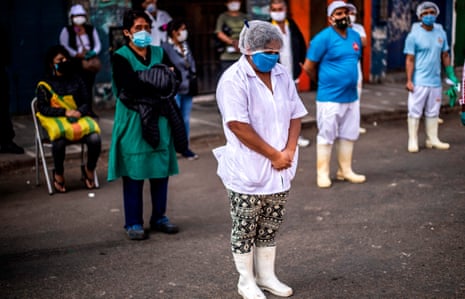Peru seemed to be doing everything right.
Its president, Martín Vizcarra, announced one of the earliest coronavirus lockdowns in Latin America on 16 March.
In stark contrast to his Brazilian counterpart, Jair Bolsonaro – who has deliberately undermined social distancing and quarantine measures – Peru’s leader strictly adhered to the World Health Organization’s coronavirus recommendations and mobilised the police and army to enforce a stringent quarantine.
But more than two months later the country is one of the region’s worst-hit by Covid-19 and has been unable to flatten the curve of infections. Peru now ranks second only to Brazil in Latin America with 104,020 confirmed cases and a death toll of 3,024 according to official figures on Tuesday.
Vizcarra said on Friday that Peru had carried out 600,000 coronavirus tests – “more than any other country in the region”. But while Peru’s numbers could reflect increased and better targeted testing rather than an underlying trend, the jump in new cases is undeniable. In the past week, the number of new Covid-19 cases logged each day rose from more than 3,000 to above 4,000 a day, hitting a record 4,550 new cases on Tuesday.
“Peru’s response was right on time,” said Elmer Huerta, a Peruvian doctor and trusted broadcaster on public health matters for Latin American audiences. “It was the first country in Latin America to respond with a lockdown.
“But the problem was people’s behaviour,” he said. “The fact that on the eighth week of confinement you have thousands of people who are positive [for Covid-19] means that those people got the virus while the country was in lockdown – which means they did not respect the law.”
Deadly outbreaks on Peru’s northern coast and Amazon regions – where social distancing was routinely flouted – laid bare the gaping holes in Peru’s chronically underfunded healthcare system. Covid-19 hit Peru’s largest Amazon city, Iquitos, with deadly force before spreading to Pucallpa, on the country’s eastern border with Brazil.

“It’s just heartbreaking,” said Miguel Hilario-Manenima, a local university professor, who said Pucallpa’s public hospitals had shut down and speculation had quintupled the price of an oxygen cylinder. “We feel abandoned by the central government and ignored by the local government,” said Hilario-Manenima, an indigenous Shipibo-Konibo leader.
“For the communities further in the forest, it’s as if they were sentenced to die,” he added. “For the poorest of the poor, what can they do?”
As elsewhere, the coronavirus has hit the poorest hardest. In one Shipibo-Konibo community living in Cantagallo, a riverside settlement of wooden shacks in Lima, tests revealed 72%, or 476 people, had Covid-19 after three died from the virus.
The coronavirus has also hit those on the frontline of the pandemic. More than 4,000 police officers have contracted the virus and 82 have died. The virus has killed 180 prison inmates and 12 guards – and also claimed the lives of dozens of doctors and nurses.
In Lima, the city hailed as South America’s gastronomic capital, food markets have emerged as major hubs of infection, as spot tests showed most traders were asymptomatic carriers of Covid-19.
“We are so proud of our culinary tradition, our cooking methods and the freshness of our ingredients,” said Hugo Ñopo, a lead researcher at Grade, a development thinktank. “But we forgot the objective was not just to minimise our journeys outside but also to maximize our social distancing.”
Ñopo pointed out that despite Peru’s fast-growing economy more than 70% of its labour force work in the informal or unregulated economy and about 40% are self-employed, the highest rate in the region.
“Some may be living the entrepreneurial dream but many are Uber drivers. For these kind of workers there is no lockdown,” he said. While figures from the Google mobility project indicated a significant reduction in movement in Peru, the quarantine may not have been as effective as intended.
Tens of thousands fled the capital to their rural home towns on foot as the lockdown left them jobless and unable to pay rent. A huge financial stimulus package worth $26bn – about 12% of Peru’s GDP – which included roughly 7m payments to poor families reportedly failed to reach more than half of them.
Despite having Latin America’s lowest debt-to-GDP ratio before the pandemic began, Peru has long had one of the region’s lowest levels of public investment in education and healthcare, which has fatally undermined its ability to respond to the pandemic, said Huerta. “These are not failures of the healthcare system, these are the consequences of a neglected healthcare system over decades,” he said.
Ñopo said the historic lack of investment in public institutions left Peru vulnerable in the face of the pandemic. “Our social contract was broken and nobody bothered to fix it. Now it’s exploding in our faces,” he said.
